Keio University: Hyperloop and the Future of Transportation
Keio Alpha Hyperloop Team
Graduate School of System Design and Management
About Hyperloop and Keio Alpha
What will the future of transportation look like? Some people may think of a train travelling a tube at impossible speeds. It may sound like something straight out of science fiction, but a team of graduate students at Keio are currently developing a prototype for a such a vehicle.
In 2013, SpaceX founder Elon Musk shared his vision for a next-generation transportation system called Hyperloop. The Hyperloop system consists of fast-moving vehicles, called pods, that levitate inside of a vacuum tube. The air pressure inside these tubes is reduced to just 0.1% the Earth’s atmosphere, which minimizes air resistance, or drag, and allows them to reach speeds of up to 1,200 kilometers per hour. While Elon Musk is not directly involved in the development of a Hyperloop, two venture-backed companies have taken up the burden of its development and implementation.
Musk does, however, want to help accelerate the development of a functioning prototype, and last summer SpaceX announced their first Hyperloop Pod Competition. The contest invited engineering teams from universities around the world to design and build pod prototypes that can run inside of a Hyperloop tube.
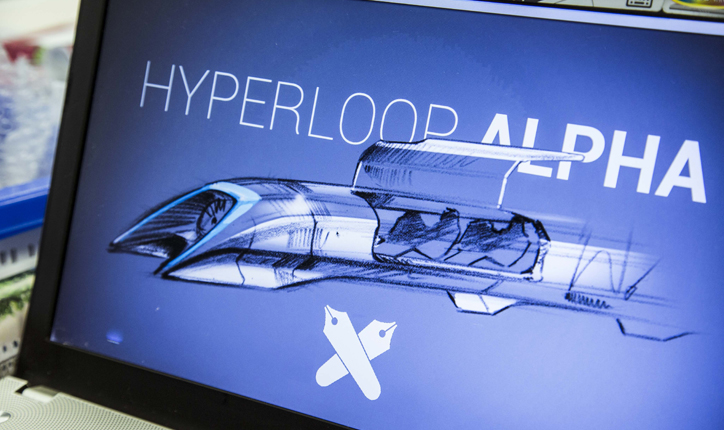
Of the over 120 participating teams, the Keio Alpha team from Keio’s Graduate School of System Design and Management (SDM) was one of only a handful of teams from Asia to make it to the two-day design competition held at Texas A&M University in January 2016. A truly international group of eight, comprised of one Japanese student and international students from China (2), Malaysia (2), Indonesia (1), Mexico (1), and Thailand (1), Keio Alpha was the only team from Asia chosen to advance to the next round of competition, one of only 29 other teams to advance.
What Makes Keio Alpha Different
What is different about the pod that Keio Alpha is making? “We thought that we may be able to build a low-cost system similar to the maglev Chuo Shinkansen, which is currently being developed in Japan,” explains Malaysia-born team leader David Chew. “It would be extremely costly to use aerodynamic force in a levitation system, for example. So, here at Keio Alpha, we have opted to use permanent magnets for levitation. By doing that, we are able to build a stable system at a much lower cost.”
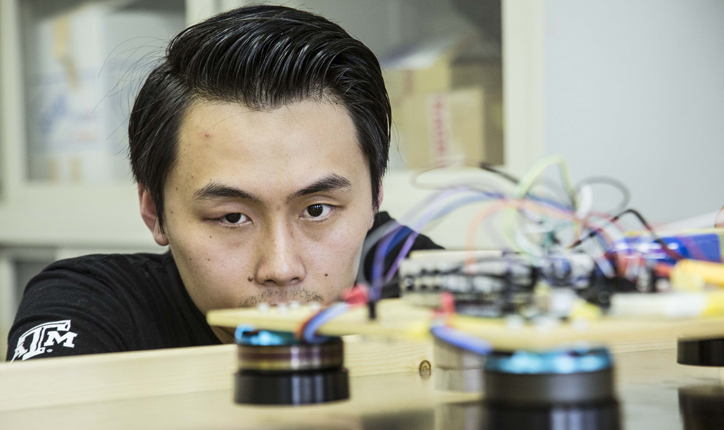
With new technologies, we tend to think too much about how to use them to build new products as soon as we get our hands on them. But Keio Alpha is different. They aren’t building their plan out from the latest technologies, but are rather reverse engineering their design, choosing the most appropriate technologies after assessing feasibility and any problems associated with its execution.
“Things become much more complicated when taken out into the real world,” proclaims team advisor Yoshiaki Ohkami, an executive advisor of SDM. “And that is exactly what we do at SDM. We unite systems thinking and design thinking to tackle real-world problems.”
The permanent magnets, chosen through SDM’s unique integrative process, will be used with rails made of aluminum, as specified by the Hyperloop system. This means that they won’t be able to use the same type of electromagnetic induction that propels the Chuo Shinkansen. They’ll actually being using something much more common, something that you may be able to find in your own home.
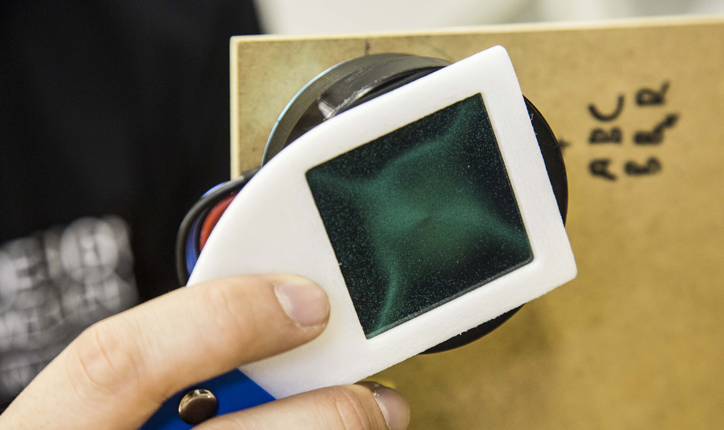
A magnetic viewing film allows us to see the four magnets housed inside of the rotor.
Many people have surely seen the silver discs spinning away inside of a common electricity meter. Those discs are actually made of aluminum. And while you would think that aluminum would not respond to a magnet, it will actually create its own opposing magnetic field when an electric current is induced by a changing magnetic field, in accordance with Lenz’s law. Indeed, the discs inside of your electricity meter also spin by the power generated by such a current and magnetic field.
Keio Alpha will employ the same principle that makes those discs spin in order to make their pod float. “Changing the magnetic field is key,” explains David. “Our current prototype uses rotors that each contain four magnets. When the rotors begin to spin, the magnetic field created changes and generates a repelling force between the pod and the aluminum rail, which causes the pod to levitate.” Furthermore, once the pod reaches a certain velocity, it will continue to levitate even if the rotors are disengaged, which allows the pod to operate at low energy.
“We plan to use a linear motor for initial propulsion. Considering the Chuo Shinkansen’s route between Tokyo and Osaka, for example, we could use a linear motor at a minimum of three strategic locations for acceleration and deceleration, which would greatly reduce cost over the current system that is being used.”
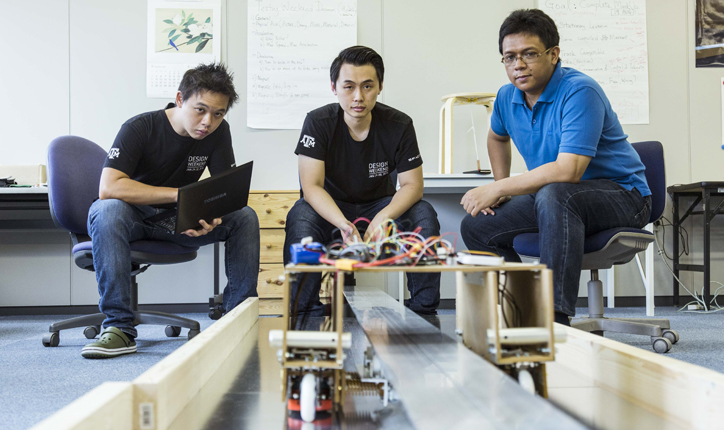
Where will the team go from here?
In their lab, Keio Alpha has already successfully run their pod prototype down a 6-meter track, levitating at a height of 8 millimeters. But what kind of challenges will they face, together with the other 29 teams, leading up to the second competition in January 2017?
“We plan to build and test our prototype this fall, which will run on the 1,500-meter test track being built in Los Angeles. If we can confirm the safety of our prototype this fall—mainly that it won’t break the test track—we should be able to squeak through to the next round,” says David.
But there are still some technical issues to be sorted out before the team can pass that safety check. One issue is the braking system. Since there is nowhere to run the prototype at actual speeds here in Japan, the team needs to figure out another way of testing their braking system. They also need a physical understanding of what will happen when the magnets are moving at such high speeds, a challenging problem even for researchers who specialize in this field.
“Unlike stationary magnets, there are many more elements that interfere with the surroundings. Plus, since the tube that the pod will run inside of has very low pressure, so we will not be able to release heat from the pod into the air. That makes it difficult to anticipate how parts that are commonly used in normal pressure systems, like motors, batteries, and even grease, will work in a low-pressure environment,” explains David.
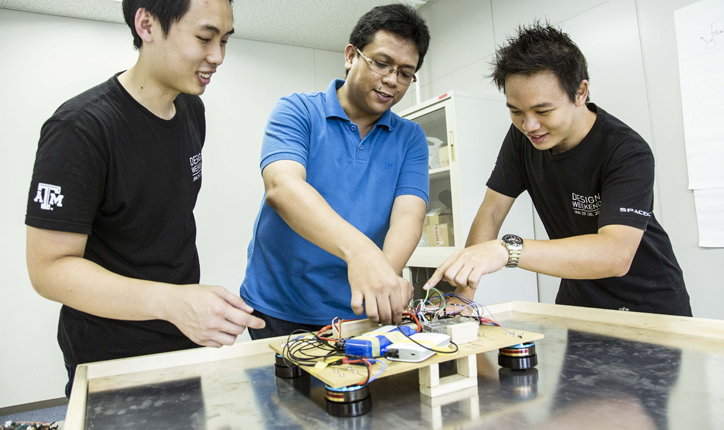
All designs from the competition will be open source. This means that there should be a wealth of quality ideas when a Hyperloop system is ready to be implemented in the near future. And Keio Alpha’s ideas may be the ones that help shape that future—but what kind of future is the team imagining?
Despite their strong backgrounds in the natural sciences and engineering, the members are mindful of their project’s implications in greater society. David is one of the members who first heard about the competition and proposed that they form a team.
“I majored in mechanical engineering back in Malaysia, but after graduating I really wanted to learn more about connecting technology and design with business. That’s when I chose Keio and SDM,” says David, with a look in his eye, as if he is envisioning how the Hyperloop could open up new ways of travel in his home country, whose numerous islands are separated by water.
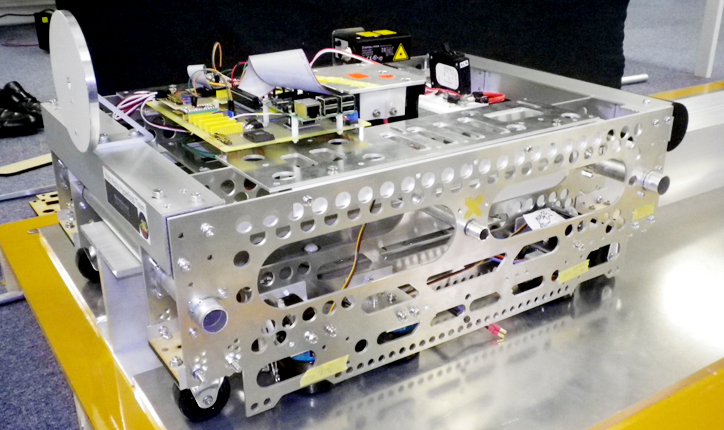
Keio Alpha’s latest prototype ahead of tests in November 2016.
The word alpha of course means “the first,” and Keio Alpha hopes to be the first to design a system that the world will need in the near future, and for now, their dream is not losing any momentum.
All information is current as of September 2016.
All information is current as of September 2016.
・Keio Alpha Hyperloop Team Website(http://keioalpha.wixsite.com/hyperloop)
・Keio Alpha Hyperloop Team Facebook Page(https://www.facebook.com/keioalphahyperloop/)
Keio University: Hyperloop and the Future of Transportation
 Reviewed by Humana Digital Media
on
02:21
Rating:
Reviewed by Humana Digital Media
on
02:21
Rating:
 Reviewed by Humana Digital Media
on
02:21
Rating:
Reviewed by Humana Digital Media
on
02:21
Rating:














Nenhum comentário: